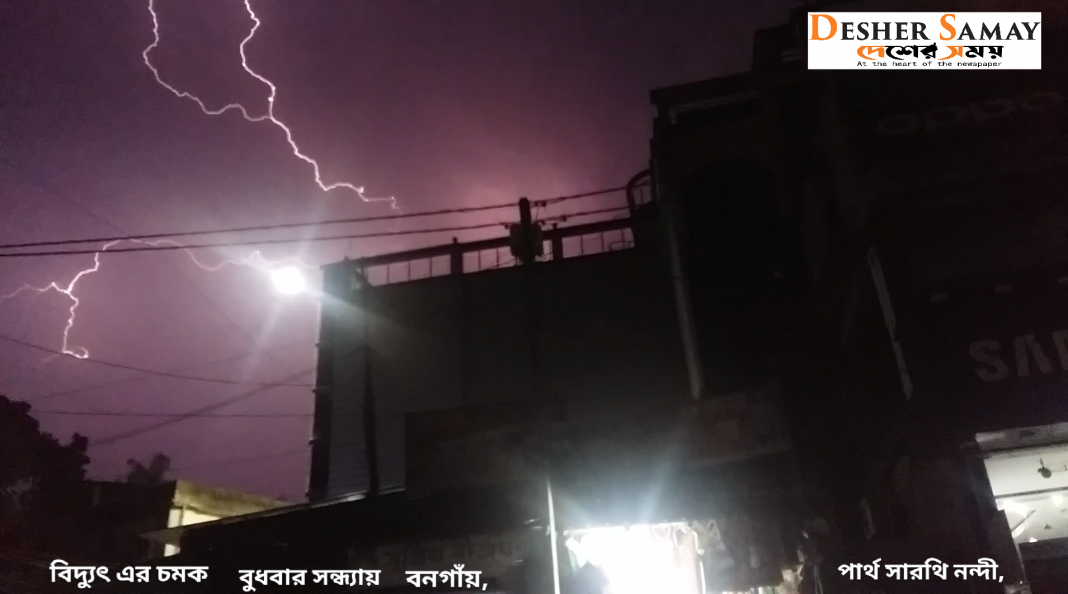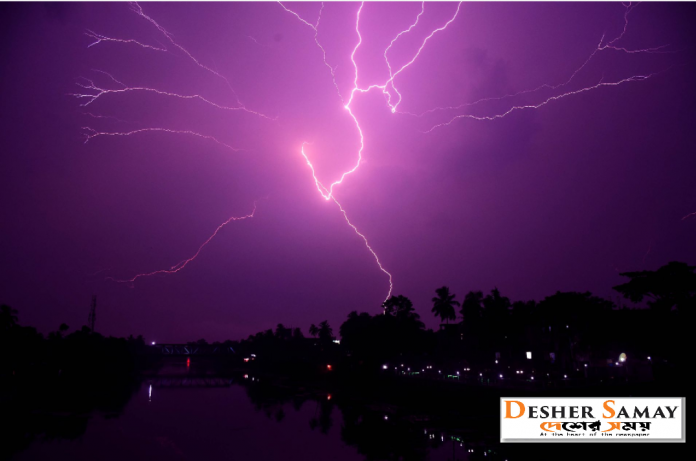By our special correspondent
With death of a person in Victoria memorial on Friday in lightning and injuring 16 others brings a fact that the cause of frequent lightning to be investigated to prevent loss of life.

The rapid heating and cooling of the gases within a lightning bolt produces nitric oxide (NO), which combines with oxygen to create nitrogen dioxide (NO2), especially when it’s moving downwind. Nitric oxide and nitrogen dioxide are referred to together as nitrogen oxides (NOx), a mixture of gases. When nitrogen oxides are created in the atmosphere during a storm, the resulting atmospheric chemistry causes one of the primary air pollutants, ground-level ozone (O3), to change.
Lightning-generated nitrogen oxides have a relatively small but potentially significant impact on ground-level ozone. As air quality regulations are tightened and the contribution of anthropogenic sources to ground-level ozone levels is reduced, it becomes more important to understand the contribution of natural sources.
While the potential contribution of lightning to air pollution has been recognized by scientists for a long time, large uncertainties remain regarding lightning strikes and lightning-generated nitrogen oxides in air quality models. EPA researchers aim to reduce these uncertainties by adding the capability to assess the impact of lightning-produced nitrogen oxides on air pollution to the Agency’s Community Multiscale Air Quality Modeling System (CMAQ). This model is used by states to implement the nation’s air quality standards.
This addition to CMAQ is expected to broaden our understanding of lightning’s potential impacts on ground-level ozone pollution.
“Over the past two decades, CMAQ has gone through rigorous development and evaluation, thus it represents the state-of-the-art air quality modeling system,” explains EPA researcher Daiwen Kang. “As a ‘one-atmosphere’ model, CMAQ simulates the transport and fate of air pollutants from local to continental scales and from hour or even minute time intervals to years. These features enable us to assess both the short and long-term impacts of lightning on air pollution over different geographic boundaries.”
The contribution of lightning-produced changes in atmospheric chemistry to overall air quality is determined by several intertwined factors in the atmospheric system, including the amounts and locations of human-produced air emissions. That’s why researchers need to use innovative air quality models, such as CMAQ, to truly understand the impacts. As the National Air Quality Standards (NAAQS) for ground-level ozone have been set to protect public health, ozone resulting from the influence of humans has been reduced. From 2000 to 2017, there was a 17% decrease in the national average of ozone because of these efforts. Now, to improve the accuracy of air quality predictions, it is important to evaluate the impact that natural sources, such as lightening-generated nitrogen oxides, may have on ground-level ozone.

As per Nasa’s Goddard meteorologist Thomas Bell the explanation is that the storms need to start their growth in a hot, humid environment to give the pollution “something to work with.” The pollution causes the storm to climb to higher altitudes, because it causes the cloud droplets being formed in the storm to be smaller than they would be in a clean environment. They’re lighter and are carried up higher than usual, where they freeze (releasing latent heat), which pumps the storm up more than would happen in clean air.
The environment needs to be hot in order to have the capacity to push the storm up to altitudes where freezing can occur. The environment also needs to be humid because when the storm grows more vigorously it “sucks” air at its base up more strongly, pulling in more moisture, which then provides additional energy to the storm as the moisture condenses during its climb. The western half of the country is fairly dry—even though it can be hot, there isn’t much “fuel” (moisture) to feed a storm when it tries to grow more vigorously. The Southeast is especially hot and humid in the summer, so that’s where the effect shows up best, according to our theory.We don’t have a good answer to this as yet.
The pollution should be the kind that affects cloud droplet growth. If we had to finger something, we’d probably choose the kinds of particulates that are emitted by diesel engines, because it seems that the weekly cycle in pollution is due, to a considerable extent, to the weekly cycle in transportation (probably trucking). More trucks are on the roads from Tue-Thu than they are the rest of the week. But this is more conjecture than a well-documented explanation.
The western half of the country is fairly dry—even though it can be hot, there isn’t much “fuel” (moisture) to feed a storm when it tries to grow more vigorously. The Southeast is especially hot and humid in the summer, so that’s where the effect shows up best, according to our theory.We don’t have a good answer to this as yet.
The pollution should be the kind that affects cloud droplet growth. If we had to finger something, we’d probably choose the kinds of particulates that are emitted by diesel engines, because it seems that the weekly cycle in pollution is due, to a considerable extent, to the weekly cycle in transportation (probably trucking). More trucks are on the roads from Tue-Thu than they are the rest of the week. But this is more conjecture than a well-documented explanation.













